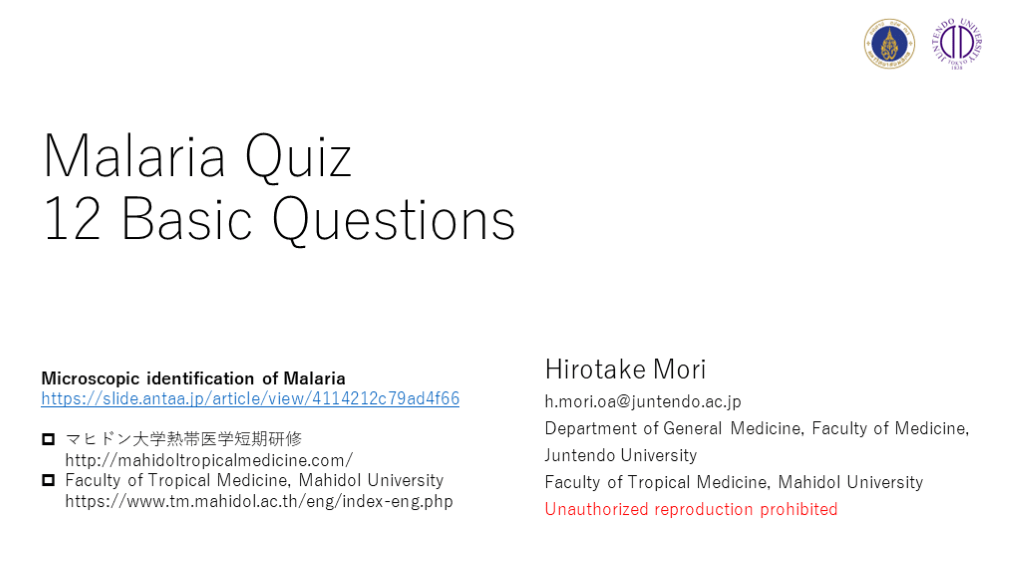

























関連テーマから出会おう。
閲覧履歴からのおすすめ
1/28
関連するスライド
2025.10.16時点のCOVIDとインフルエンザのまとめ
新米ID
2065873
6509
抗酸菌検査の基本と結果の解釈 〜結核 Tuberculosis〜
番場祐基
15315
69
とっても簡単な、破傷風予防の対応
松浦良樹
47326
489
針刺し事故対応をちょっと勉強したい方へ
松浦良樹
44568
170
Malaria Quiz 12 Basic Questions
1,355
3
概要
Malaria Quiz 12 Basic Questions
本スライドの対象者
専攻医/専門医
投稿された先生へ質問や勉強になったポイントをコメントしてみましょう!
0 件のコメント
森博威さんの他の投稿スライド
このスライドと同じ診療科のスライド
テキスト全文
マラリアクイズの概要と目的
#1.
Malaria Quiz 12 Basic Questions Hirotake Mori h.mori.oa@juntendo.ac.jp Department of General Medicine, Faculty of Medicine, Juntendo University Faculty of Tropical Medicine, Mahidol University Unauthorized reproduction prohibited Microscopic identification of Malaria https://slide.antaa.jp/article/view/4114212c79ad4f66 マヒドン大学熱帯医学短期研修 http://mahidoltropicalmedicine.com/ Faculty of Tropical Medicine, Mahidol University https://www.tm.mahidol.ac.th/eng/index-eng.php
#2.
Introduction Malarial parasite microscopy characteristics will be used in a quiz format to explain. Please study using slideshow. Images published in Mahidol University Faculty of Tropical Medicine’s Atlas, and those seen in real life will be used. In clinical practice, there are many cases in which the images are not as easy to interpret as the ones in textbooks. Points used in the diagnosis of malaria are summarised in “malaria diagnosis points”. “Basic” will include easy to understand stereotypical/textbook cases. “Advanced” will include atypical examples at random.
マラリアの種類と特徴の記述
#3.
Malaria Quiz Please write the type (species) of malaria, its characteristics, and the stage of infection. Extract from Atlas of Medical Parasitology (Faculty of Tropical Medicine, Mahidol University)
#4.
Malaria Quiz P. falciparum Ring form stage (early trophozoite). A characteristic of the ring form of P. falciparum is a thin cytoplasm. Double infection, double chromatin is also observed. This is a typical finding in P. falciparum.
#5.
Malaria Quiz Please write the type (species) of malaria, its characteristics, and the stage of infection. Extract from Atlas of Medical Parasitology (Faculty of Tropical Medicine, Mahidol University)
P. falciparumの成長段階と特徴
#6.
Malaria Quiz P. falciparum Growing trophozoite This is the growing trophozoite stage of P. falciparum, a stage not commonly observed. Infected erythrocytes are not enlarged. Although few in number, Maurer's dots can also be seen.
#7.
Malaria Quiz Please write the type (species) of malaria, its characteristics, and the stage of infection. Extract from Atlas of Medical Parasitology
#8.
Malaria Quiz P. falciparum Schizont stage This is the schizont stage of P. falciparum.A large number of merozoites can be seen interiorly. Although difficult to count precisely, there appears to be around 20 merozoites. The brown colour in the center is malaria pigment.
P. vivaxの成長段階と特徴
#9.
Malaria Quiz Please write the type (species) of malaria, its characteristics, and the stage of infection. Extract from Atlas of Medical Parasitology
#10.
Malaria Quiz P. vivax Growing trophozoite stage Given a large infected erythrocyte and the presence of Schuffner’s dots, P. vivax is diagnosed. Two parasites are observed so double infection is diagnosed. A growing trophozite is concluded as the parasite cytoplasm is not enlarged.
#11.
Malaria Quiz Please write the type (species) of malaria, its characteristics, and the stage of infection. Extract from Atlas of Medical Parasitology
P. vivaxの成熟段階と特徴
#12.
Malaria Quiz P. vivax Late trophozoite stage P. vivax is diagnosed given the presence of Schuffner’s dots and a large infected erythrocyte. This parasite has a large cytoplasm and small vacuole so a late trophozoite is determined. Early trophozoite (ring form). The parasite cytoplasm is thin and the vacuole large giving a ring-like appearance. Growing trophozoite. The cytoplasm becomes thicker and the vacuole decreases in size. Late trophozoite. The parasite cytoplasm occupies a large portion of the erythrocyte and the vacuole becomes even smaller.
#13.
Malaria Quiz Please write the type (species) of malaria, its characteristics, and the stage of infection. Extract from Atlas of Medical Parasitology
#14.
Malaria Quiz P. vivax Schizont stage (mature schizont). P. vivax is diagnosed given the presence of Schuffner’s dots and a large infected erythrocyte. 16 merozoites can be seen. The number of merozoites is also consistent with P. vivax.
P. ovaleの成長段階と特徴
#15.
Malaria Quiz Please write the type (species) of malaria, its characteristics, and the stage of infection. Extract from Atlas of Medical Parasitology
#16.
Malaria Quiz P. vivax Gametocyte (macrogametocyte) P. vivax is diagnosed given the presence of Schuffner’s dots and a large infected erythrocyte. Chromatin can be seen at the edge of the nucleus; a macrogametocyte is diagnosed.
#17.
Malaria Quiz Please write the type (species) of malaria, its characteristics, and the stage of infection. Extract from Atlas of Medical Parasitology
P. ovaleの成熟段階と特徴
#18.
Malaria Quiz P. ovale Growing trophozoite The infected erythrocytes are large and distorted (fimbriated). Schuffner’s dots are also present so P. ovale is diagnosed. This is a stereotypical finding in P. ovale.
#19.
Malaria Quiz Please write the type (species) of malaria, its characteristics, and the stage of infection. Extract from Atlas of Medical Parasitology
#20.
Malaria Quiz P. ovale Schizont stage The infected erythrocyte is large and distorted (fimbriated). Schuffner’s dots are also present so P. ovale is diagnosed. 8 merozoites can be seen interiorly. Schizont stage is diagnosed.
P. malariaeの成長段階と特徴
#21.
Malaria Quiz Please write the type (species) of malaria, its characteristics, and the stage of infection. Extract from Atlas of Medical Parasitology
#22.
Malaria Quiz P. ovale Gametocyte (microgametocyte) The infected erythrocyte is large and distorted (fimbriated). Schuffner’s dots are also present so P. ovale is diagnosed. A microgametocyte was diagnosed as chromatin is not observed.
#23.
Malaria Quiz Please write the type (species) of malaria, its characteristics, and the stage of infection. Extract from Atlas of Medical Parasitology
P. malariaeの成熟段階と特徴
#24.
Malaria Quiz P. malariae Growing trophozoite (band form). The infected erythrocyte is not enlarged and there are no dots. On top of this, the characteristic band-form finding is present allowing us to diagnose P. malariae.
#25.
Malaria Quiz Please write the type (species) of malaria, its characteristics, and the stage of infection. Extract from Atlas of Medical Parasitology
#26.
Malaria Quiz P. malariae Late trophozoite The infected erythrocyte is not enlarged and there are no dots. The diagnosis is P. malariae.
マラリアクイズのまとめと終了
#27.
